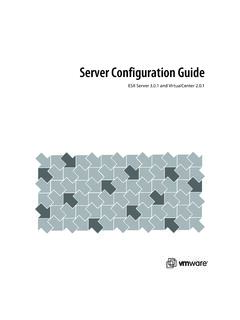Transcription of VLAN Configuration - Cisco
1 CHAPTER11-1 Cisco Connected Grid Ethernet Switch Module Software Interface Card Configuration GuideOL-23422-0311 VLAN ConfigurationThis chapter describes how to configure normal-range vlans (VLAN IDs 1 to 1005) and extended-range vlans (VLAN IDs 1006 to 4094) on the CGR 2010 ESM. It includes information about VLAN membership modes, VLAN Configuration modes, VLAN trunks, and dynamic VLAN assignment from a VLAN Membership Policy Server (VMPS). NoteFor complete syntax and usage information for the commands used in this chapter, see the online Cisco IOS Interface Command Reference, Release understanding vlans , page 11-1 Creating and Modifying vlans , page 11-7 Displaying vlans , page 11-15 configuring VLAN Trunks, page 11-15 configuring VMPS, page 11-24 understanding VLANsA VLAN is a switched network that is logically segmented by function, project team, or application, without regard to the physical locations of the users.
2 vlans have the same attributes as physical LANs, but you can group end stations even if they are not physically located on the same LAN segment. Any switch module port can belong to a VLAN, and unicast, broadcast, and multicast packets are forwarded and flooded only to end stations in the VLAN. Each VLAN is considered a logical network, and packets destined for stations that do not belong to the VLAN must be forwarded through a router, as shown in Figure 11-1. Because a VLAN is considered a separate logical network, it contains its own bridge MIB information and can support its own implementation of spanning tree. See Chapter 17, configuring STP in the Cisco CGS 2520 Software Configuration Connected Grid Ethernet Switch Module Software Interface Card Configuration GuideOL-23422-03 Chapter 11 VLAN Configuration understanding VLANsFigure 11-1 shows an example of vlans segmented into logically defined 11-1 vlans as Logically Defined NetworksVLANs are often associated with IP subnetworks.
3 For example, all the end stations in a particular IP subnet belong to the same VLAN. Interface VLAN membership on the switch module is assigned manually on an interface-by-interface basis. When you assign switch module interfaces to vlans by using this method, it is known as interface-based, or static, VLAN switch module does not support VLAN Trunking Protocol (VTP).Traffic between vlans must be routed. Switch modules that are running the IP services image can route traffic between vlans by using Switch Virtual Interfaces (SVIs). To route traffic between vlans , an SVI must be explicitly configured and assigned an IP address. For more information, see the Switch Virtual Interfaces section on page 8-5 and the configuring Layer 3 Interfaces section on page section includes these topics: Supported vlans , page 11-2 Normal-Range vlans , page 11-3 Extended-Range vlans , page 11-4 VLAN Port Membership Modes, page 11-4 UNI-ENI vlans , page 11-5 Supported VLANsVLANs are identified with a number from 1 to 4094.
4 VLAN IDs 1002 through 1005 are reserved for Token Ring and FDDI vlans . VLAN IDs greater than 1005 are extended-range vlans and are not stored in the VLAN database. Floor 1 Floor 2 EngineeringVLANC isco routerGigabitEthernetFloor 3 MarketingVLANA ccountingVLAN9057111-3 Cisco Connected Grid Ethernet Switch Module Software Interface Card Configuration GuideOL-23422-03 Chapter 11 VLAN Configuration understanding VLANsAlthough the switch module supports a total of 1005 (normal-range and extended-range) vlans , the number of routed ports, SVIs, and other configured features affects the use of the switch module hardware. The switch module supports per-VLAN spanning-tree plus (PVST+) or rapid PVST+ with a maximum of 128 spanning-tree instances. One spanning-tree instance is allowed per VLAN. NoteNetwork node interfaces (NNIs) support STP by default.
5 Enhanced network interfaces (ENIs) can be configured to support STP. User network interfaces (UNIs) do not support STP and by default are always in a forwarding the VLAN Configuration Guidelines section on page 11-8 for more information about the number of spanning-tree instances and the number of vlans . The switch module supports IEEE trunking for sending VLAN traffic over Ethernet VLANsNormal-range vlans are vlans with VLAN IDs 1 to 1005. You can add, modify or remove configurations for vlans 2 to 1001 in the VLAN database. (VLAN IDs 1 and 1002 to 1005 are automatically created and cannot be removed.) Configurations for VLAN IDs 1 to 1005 are written to the file (VLAN database), and you can display them by entering the show vlan privileged EXEC command. The file is stored in flash memory.
6 CautionYou can cause inconsistency in the VLAN database if you try to manually delete the file. If you want to modify the VLAN Configuration , use the commands described in these sections and in the command reference for this release. You can set these parameters when you create a new normal-range VLAN or modify an existing VLAN in the VLAN database: VLAN ID VLAN name VLAN type (Ethernet, Fiber Distributed Data Interface [FDDI], FDDI network entity title [NET], TrBRF, or TrCRF, Token Ring, Token Ring-Net)NoteThe switch module supports only Ethernet vlans . You can configure parameters for FDDI and Token Ring vlans and view the results in the file, but these parameters are not used. VLAN state (active or suspended) Maximum transmission unit (MTU) for the VLAN Security Association Identifier (SAID) Bridge identification number for TrBRF vlans Ring number for FDDI and TrCRF vlans Parent VLAN number for TrCRF vlans Spanning Tree Protocol (STP) type for TrCRF VLANs11-4 Cisco Connected Grid Ethernet Switch Module Software Interface Card Configuration GuideOL-23422-03 Chapter 11 VLAN Configuration understanding vlans VLAN number to use when translating from one VLAN type to another Private VLAN.
7 Configure the VLAN as a primary or secondary private VLAN. For information about private vlans , see Chapter 12, Private VLAN Configuration . Remote SPAN VLAN. Configure the VLAN as the Remote Switched Port Analyzer (RSPAN) VLAN for a remote SPAN session. For more information on remote SPAN, see Chapter 29, configuring SPAN and RSPAN in the CGS 2520 Software Configuration Guide. UNI-ENI VLAN configurationFor extended-range vlans , you can configure only MTU, private VLAN, remote SPAN VLAN, and UNI-ENI VLAN chapter does not provide Configuration details for most of these parameters. For complete information on the commands and parameters that control VLAN Configuration , see the command reference for this VLANsYou can create extended-range vlans (in the range 1006 to 4094) to enable service providers to extend their infrastructure to a greater number of customers.
8 The extended-range VLAN IDs are allowed for any switchport commands that allow VLAN IDs. Extended-range VLAN configurations are not stored in the VLAN database, but they are stored in the switch module running Configuration file, and you can save the Configuration in the startup Configuration file by using the copy running-config startup-config privileged EXEC the switch module supports 4094 VLAN IDs, the actual number of vlans supported is Port Membership ModesYou configure a port to belong to a VLAN by assigning a membership mode that specifies the kind of traffic that the port carries and the number of vlans to which it can belong. Ta b l e 1 1- 1 lists the membership modes and 11-1 Port Membership ModesMembership ModeVLAN Membership CharacteristicsStatic-accessA static-access port can belong to one VLAN and is manually assigned to that VLAN.
9 For more information, see the Assigning Static-Access Ports to a VLAN section on page 11-11. Trunk ( ) A trunk port is a member of all vlans by default, including extended-range vlans , but membership can be limited by configuring the allowed-VLAN information about configuring trunk ports, see the configuring an Ethernet Interface as a Trunk Port section on page Connected Grid Ethernet Switch Module Software Interface Card Configuration GuideOL-23422-03 Chapter 11 VLAN Configuration understanding VLANsFor more detailed definitions of access and trunk modes and their functions, see Table 11-4 on page a port belongs to a VLAN, the switch module learns and manages the addresses associated with the port on a per-VLAN basis. UNI-ENI VLANsThe CGR 2010 ESM is the boundary between customer networks and the service-provider network, with user network interfaces (UNIs) and enhanced interface interfaces (ENIs) connected to the customer side of the network.
10 When customer traffic enters or leaves the service-provider network, the customer VLAN ID must be isolated from other customers VLAN IDs. You can achieve this isolation by several methods, including using private vlans . On the switch module, this isolation occurs by default by using UNI-ENI vlans . Dynamic-accessA dynamic-access port can belong to one VLAN (VLAN ID 1 to 4094) and is dynamically assigned by a VMPS. The VMPS can be a Catalyst 5000 or Catalyst 6500 series switch, for example, but never a CGR 2010 ESM. The switch module is a VMPS UNIs or ENIs can be dynamic-access can have dynamic-access ports and trunk ports on the same switch module, but you must connect the dynamic-access port to an end station or hub and not to another switch Configuration information, see the configuring Dynamic-Access Ports on VMPS Clients section on page VLANA private VLAN port is a host or promiscuous port that belongs to a private VLAN primary or secondary VLAN.













